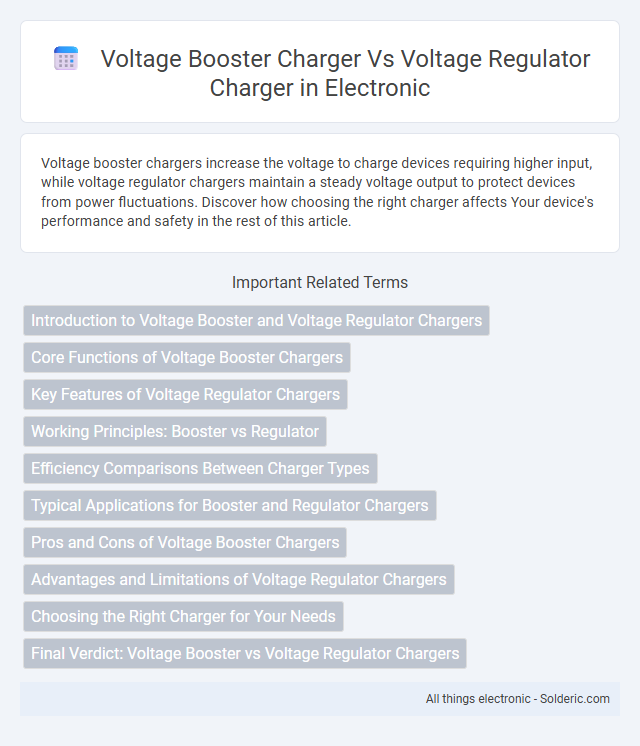Voltage booster chargers increase the voltage to charge devices requiring higher input, while voltage regulator chargers maintain a steady voltage output to protect devices from power fluctuations. Discover how choosing the right charger affects Your device's performance and safety in the rest of this article.
Comparison Table
| Feature | Voltage Booster Charger | Voltage Regulator Charger |
|---|---|---|
| Function | Increases voltage from a lower level to a higher level | Maintains a steady voltage output within a specific range |
| Use Case | Powering higher voltage devices from low voltage sources | Protecting devices from voltage fluctuations and ensuring stable charging |
| Output Voltage | Higher than input voltage | Stable, regulated voltage matching device requirements |
| Efficiency | Typically high, but depends on load and design | High efficiency with voltage stability focus |
| Applications | Battery charging where input voltage is insufficient | Battery management systems, electronics sensitive to voltage changes |
| Complexity | Moderate complexity with inductors, capacitors, and switching components | Varies; generally includes feedback circuits and voltage reference |
Introduction to Voltage Booster and Voltage Regulator Chargers
Voltage booster chargers increase the voltage output to match the device's required input voltage, ensuring stable power delivery for devices requiring higher voltage than the source provides. Voltage regulator chargers maintain a constant voltage level despite fluctuations in input voltage, protecting sensitive electronics from voltage spikes and drops. Both types are essential for optimizing charging performance and safeguarding battery health in various electronic applications.
Core Functions of Voltage Booster Chargers
Voltage booster chargers primarily increase the input voltage to a higher, stable output voltage, making them ideal for powering devices requiring higher voltage from lower voltage sources such as batteries or solar panels. Their core function is to step up voltage efficiently using DC-DC boost converter technology, ensuring consistent power delivery without draining your energy source rapidly. Unlike voltage regulator chargers that maintain a constant output voltage by bucking or boosting, voltage booster chargers specifically focus on voltage elevation to meet device requirements.
Key Features of Voltage Regulator Chargers
Voltage regulator chargers maintain a consistent output voltage to protect batteries from overcharging and ensure stable power delivery, which enhances battery longevity and device safety. They feature automatic voltage adjustment, built-in surge protection, and temperature compensation to adapt to varying load conditions and environmental factors. This precise voltage control distinguishes voltage regulator chargers from voltage booster chargers, which primarily increase voltage regardless of stability.
Working Principles: Booster vs Regulator
Voltage booster chargers increase voltage from a lower level to a higher, using inductors, capacitors, and switches to store and release energy efficiently, ideal for devices requiring higher input voltage. Voltage regulator chargers maintain a constant output voltage regardless of input fluctuations, employing components like linear regulators or switching regulators to protect sensitive electronics. Understanding these working principles helps you select the right charger to ensure optimal performance and device safety.
Efficiency Comparisons Between Charger Types
Voltage booster chargers typically offer higher efficiency in low-voltage scenarios by increasing voltage output with minimal energy loss, making them ideal for systems requiring power elevation. Voltage regulator chargers maintain consistent voltage levels but may exhibit lower efficiency due to continuous voltage adjustment and energy dissipation as heat. Efficiency comparisons reveal that booster chargers excel in scenarios demanding voltage step-up, whereas regulator chargers perform better in applications requiring voltage stability.
Typical Applications for Booster and Regulator Chargers
Voltage booster chargers are typically used in applications requiring an increase in voltage to charge batteries or power devices when the input voltage is lower than the required output voltage, such as in solar power systems and electric vehicles. Voltage regulator chargers maintain a stable output voltage regardless of input variations, making them ideal for sensitive electronics, communication equipment, and automotive battery charging. Both chargers optimize battery performance but serve distinct roles depending on whether voltage elevation or stabilization is necessary.
Pros and Cons of Voltage Booster Chargers
Voltage booster chargers increase voltage from a lower input to a higher output, making them ideal for devices requiring higher voltage than the power source provides. Pros include compatibility with low-voltage sources, compact size, and efficiency in powering high-voltage electronics. Cons involve potential noise interference, increased heat generation, and reduced battery life if not properly managed.
Advantages and Limitations of Voltage Regulator Chargers
Voltage regulator chargers maintain a consistent output voltage, ensuring stable power supply to Your devices and protecting them from voltage fluctuations and potential damage. Their primary advantage lies in enhanced safety and reliability, particularly in environments where input voltage varies significantly. However, limitations include lower efficiency compared to voltage booster chargers and potential incompatibility with devices requiring higher voltage levels than the input source provides.
Choosing the Right Charger for Your Needs
Voltage booster chargers increase the output voltage to match device requirements, ideal for powering higher-voltage equipment from lower-voltage sources, while voltage regulator chargers maintain a stable voltage output to protect sensitive electronics from voltage fluctuations. Selecting the right charger depends on your device's voltage specifications and the power source's stability; use boosters when voltage needs stepping up, and regulators to ensure consistent voltage levels. Understanding your battery chemistry and load conditions helps optimize charging efficiency and prolong battery life.
Final Verdict: Voltage Booster vs Voltage Regulator Chargers
Voltage booster chargers increase the input voltage to a higher output voltage, ideal for devices requiring more power than the power source provides, while voltage regulator chargers stabilize the voltage to a steady output, protecting sensitive electronics from fluctuations. Your choice depends on whether you need to elevate voltage for performance or maintain consistent voltage for device safety. For applications demanding precise voltage control, voltage regulator chargers offer reliability, whereas voltage booster chargers excel in enhancing power output in low-voltage scenarios.
Voltage booster charger vs voltage regulator charger Infographic

 solderic.com
solderic.com